Rulebook 1.0
Game Overview
- Number of Players: 5 to 10
- Play Time: 30 to 45 minutes
- Age Range: 10 and up
Table of Contents
- Story
- Contents
- How to Read the Cards
- Game Setup
- Round Flow
- Seal Phase and Divine Punishment Phase (Reversal) if Architects Win
- Other Important Rules
1. Story
“Then they said, “Come, let us build ourselves a city, with a tower that reaches to the heavens, so that we may make a name for ourselves; otherwise we will be scattered over the face of the whole earth.” — Genesis 11:4, NIV
Players work together to build the Tower of Babel. However, within the group lurks the “Messenger of God” and the “Zealots,” who aim to prevent the tower’s completion. Can the team of architects complete the tower, or will they be thwarted by the saboteurs? This game is based on strategy and psychological warfare.
2. Contents
- Manual QR Code Card: 1 card
- Base Card (card with a 3x3 grid): 1 card
- Material Blocks (10x10x10 mm cube blocks): 25 blocks
- Master Token (black chip): 1 token
- Architect Tokens (brown chips): 4 tokens
- Blueprint Cards (cards with tower completion conditions): 12 cards
- Pre-prepared cards: 9 cards
- Player-customizable cards (blank cards): 3 cards
- Instruction Cards (cards with construction instructions): 39 cards
- 1 Block Construction Card: 18 cards (6 cards × 3 sets)
- 2 Block Construction Card: 12 cards
- 3 Block Construction Card: 9 cards
- Special Cards: 27 cards
- Lightning Cards: 5 cards
- Storm Cards: 5 cards
- Divine Punishment Cards: 4 cards
- Seal Cards: 9 cards
- Deliberation Cards: 4 cards
- Role Cards (cards showing player roles): 10 cards
- Messenger of God: 1 card
- Architect: 9 cards
3. How to Read the Cards
- Base Card: Yellow on Back
- Field for tower construction.
- Always displayed face up in the game.
- During the construction phase, if an instruction card’s effect is used, material blocks are stacked on the designated locations on the base card.

- Blueprint Card: Yellow on Back
- Shows the tower’s completion conditions.
- The goal is to stack material blocks on each cell according to the numbers.
- In the example below, aim to stack three blocks on C1, eight on B2, and three or more on A3.
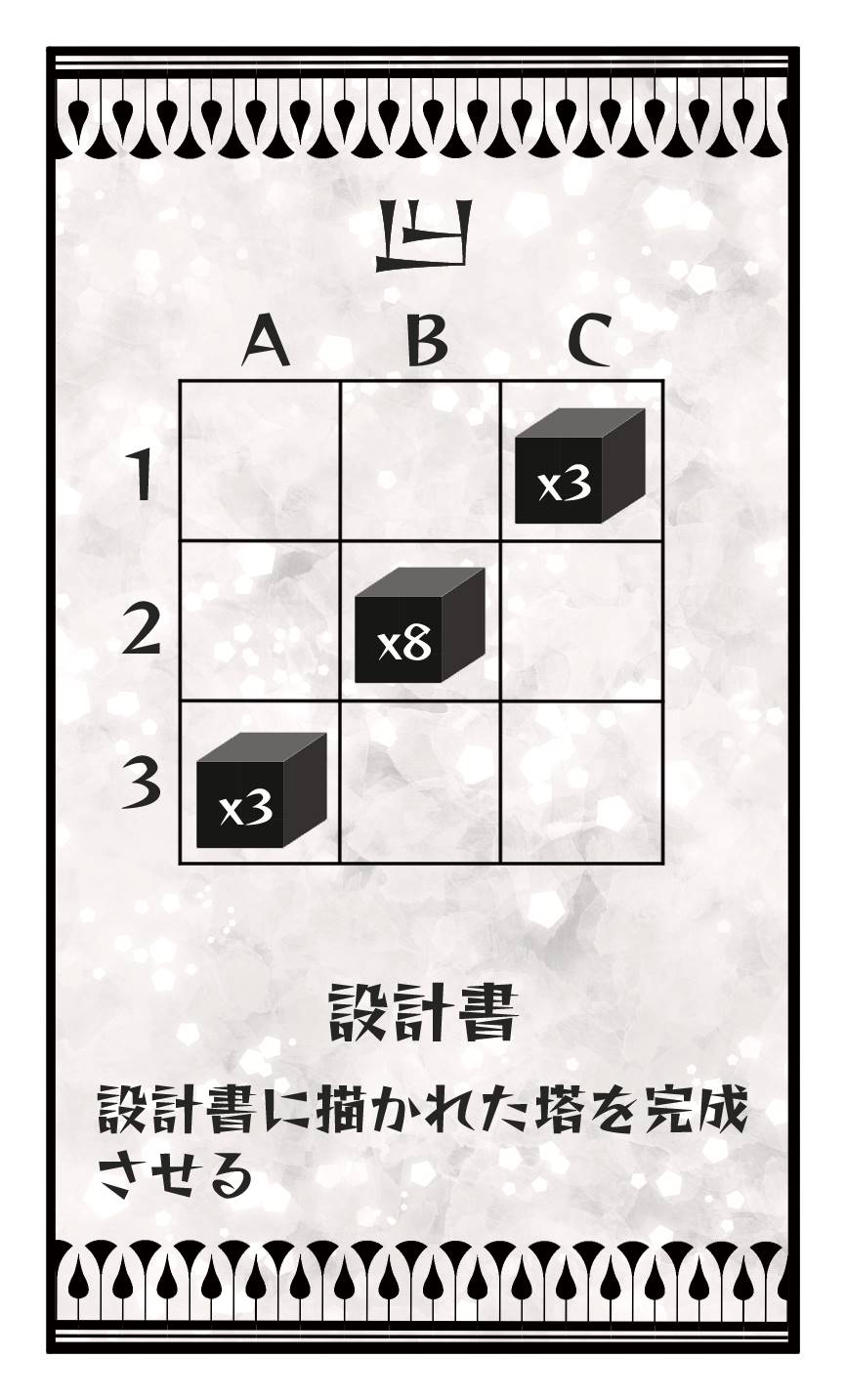
- Instruction Card: Black on Back
- Indicates where and how many material blocks can be placed during the construction phase.
- When multiple locations are available, players must choose one.
- Blocks are placed according to the number written on the cell.
- Example locations and quantities for each construction card are as follows:
- 1 Block Construction Card
- Available locations: A1 or A2 or A3
- Number of blocks: 1
- 2 Block Construction Card
- Available locations: A1 or A2
- Number of blocks: 2
- 3 Block Construction Card
- Available location: A1
- Number of blocks: 3
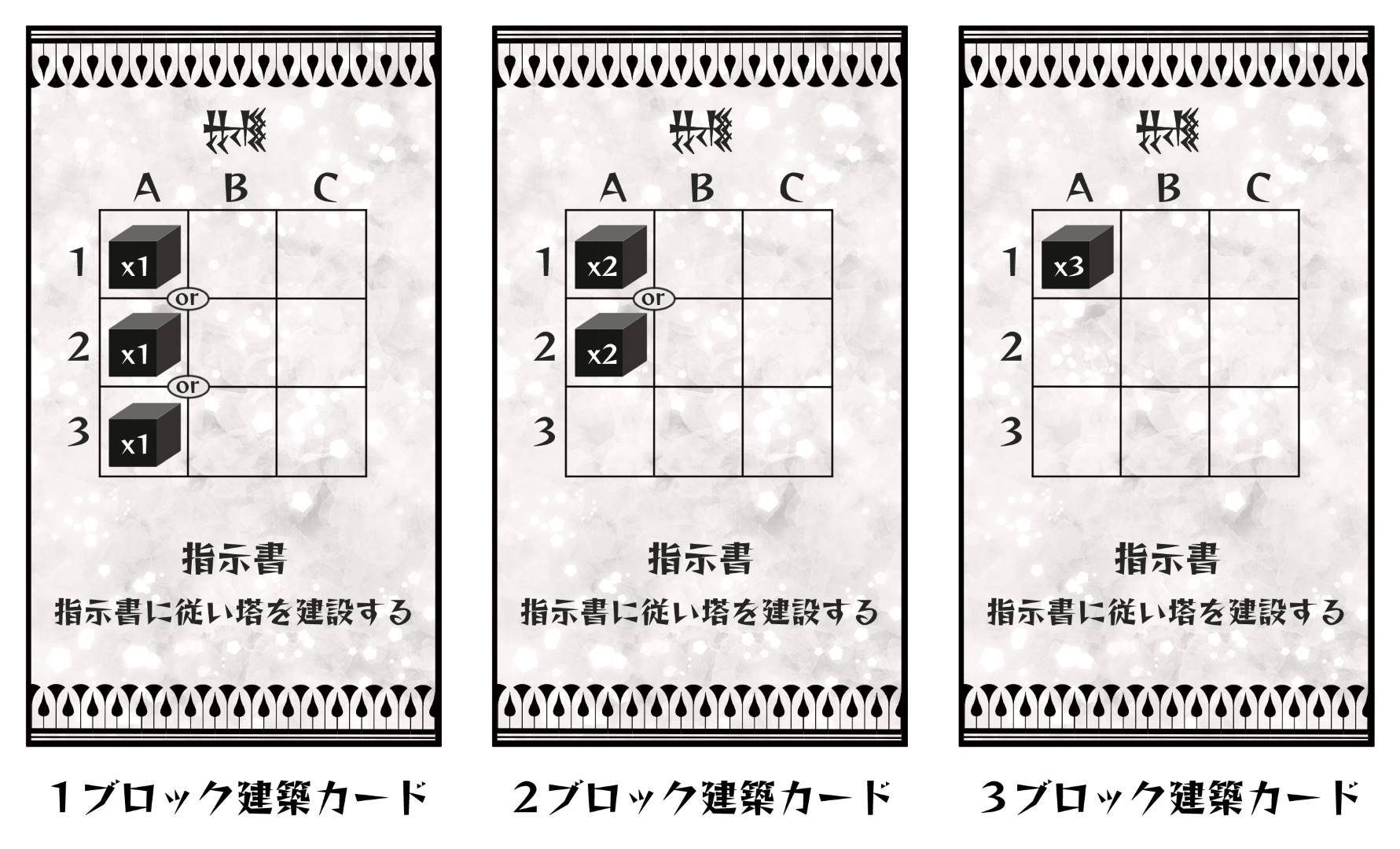
- Special Card: Black on Back
- Cards with special effects.
- Follow the instructions on the card to play.
- Check each phase’s explanation for details.
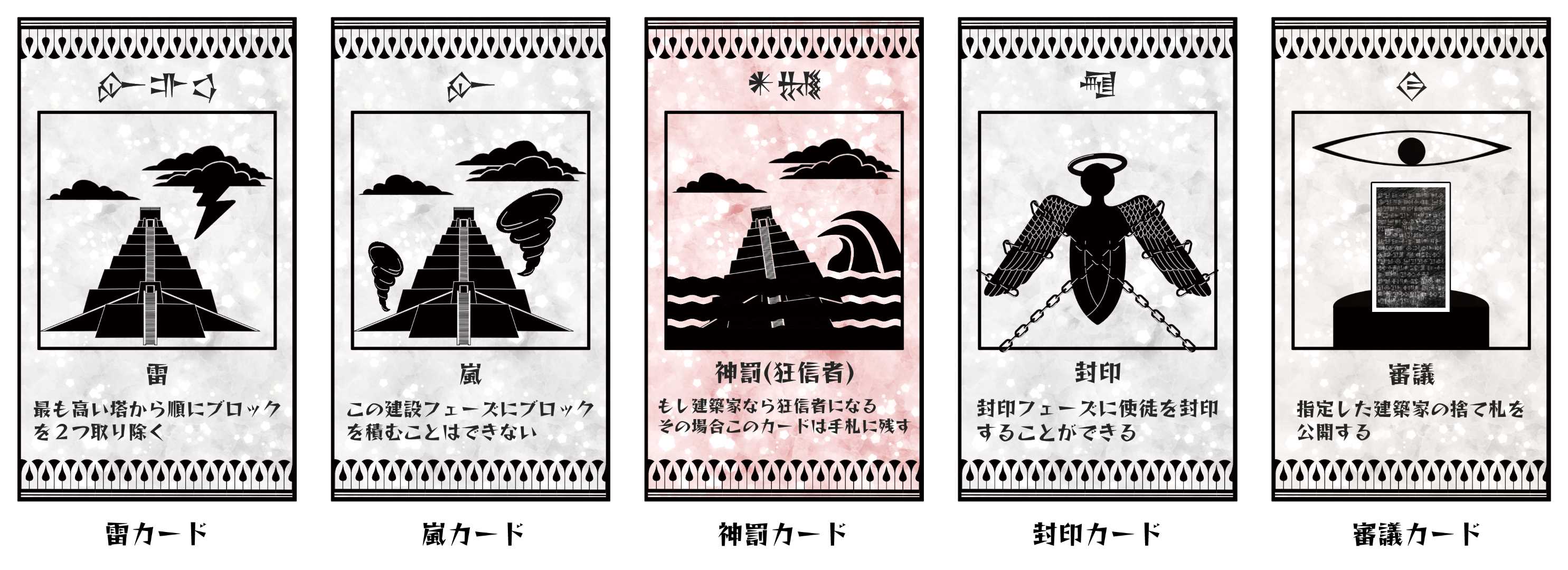
- Role Card: White on Back
- Card indicating roles.
- Note that an architect who draws a Divine Punishment card becomes a Zealot and joins the Messenger of God’s side.
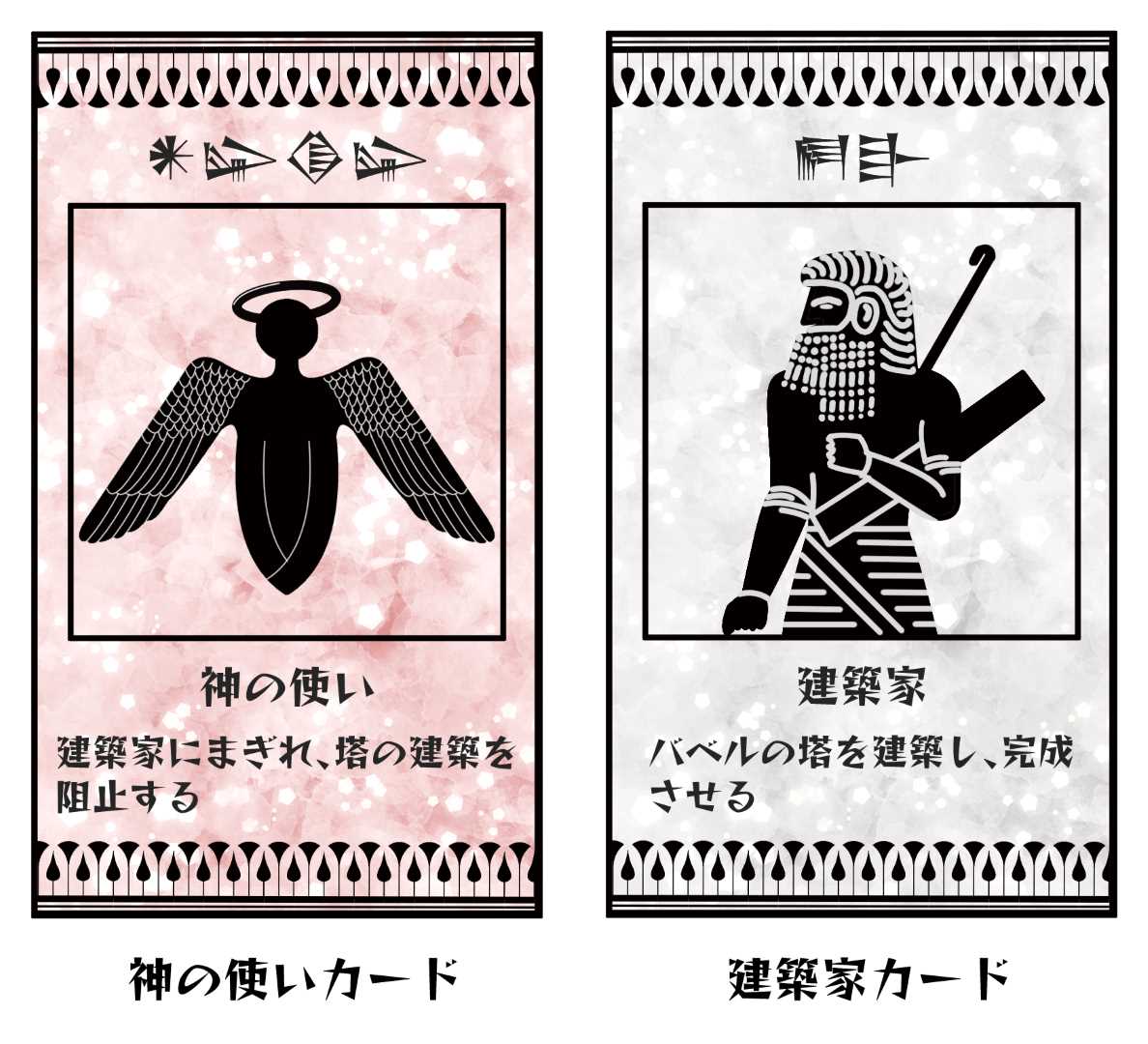
4. Game Setup
Role List Based on Number of Players
| Players | Messenger of God | Architect | (Zealot) |
|---|---|---|---|
| 5 | 1 | 4 | (1) |
| 6 | 1 | 5 | (2) |
| 7 | 1 | 6 | (2) |
| 8 | 1 | 7 | (3) |
| 9 | 1 | 8 | (3) |
| 10 | 1 | 9 | (4) |
Note: There is no specific Zealot role card.
Special Card List Based on Number of Players
| Players | Divine Punishment Card | Seal Card |
|---|---|---|
| 5 | 1 | 3 |
| 6 | 2 | 5 |
| 7 | 2 | 5 |
| 8 | 3 | 7 |
| 9 | 3 | 7 |
| 10 | 4 | 9 |
Note: All other special cards (Lightning Cards, Storm Cards, and Deliberation Cards) are used regardless of the number of players.
Game Setup Procedure
- Prepare the Role Cards
Based on the “Role List Based on Number of Players,” separate the role cards, shuffle them well, and distribute one to each player. Only the player may see their role card. - Prepare the Special Cards
Based on the “Special Card List Based on Number of Players,” set aside the Divine Punishment and Seal cards. - Set Up the Field
- Place the base card face up at the center of the table.
- Shuffle the blueprint cards and place one face up on the table.
- Create the Draw Deck
- Shuffle all instruction cards and special cards (such as Lightning and Storm cards) except for the Divine Punishment cards and create a deck.
- Take out a number of cards equal to three times the number of players minus one from the deck, add one Divine Punishment card, shuffle, and distribute three cards to each player (initial hand).
- If there are six or more players, take out two times the number of players, add the remaining Divine Punishment cards, shuffle, and place them back on top of the deck.
- Determine the Master
Randomly decide the first Master and give them the Master Token.
Example of Initial Setup (for 5 Players)
Click (or tap) to enlarge. To close, click the “✕” mark in the top right corner.
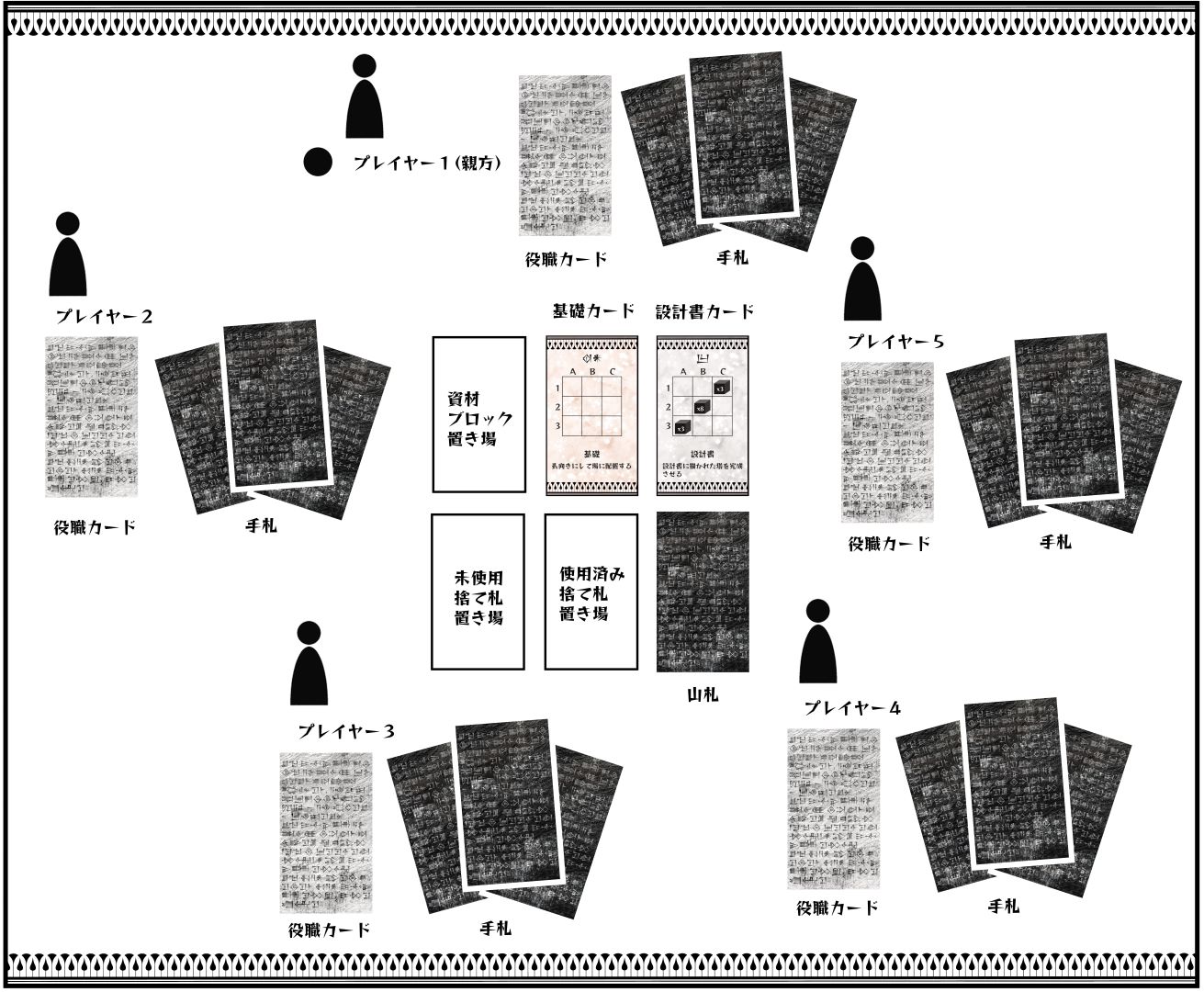
5. Round Flow
1. Architect Selection Phase
- The Master appoints Architects. For 6 players or fewer, appoint 3; for 7 or more, appoint 4.
- Distribute Architect Tokens to appointed players.
Click (or tap) to enlarge. To close, click the “✕” mark in the top right corner.
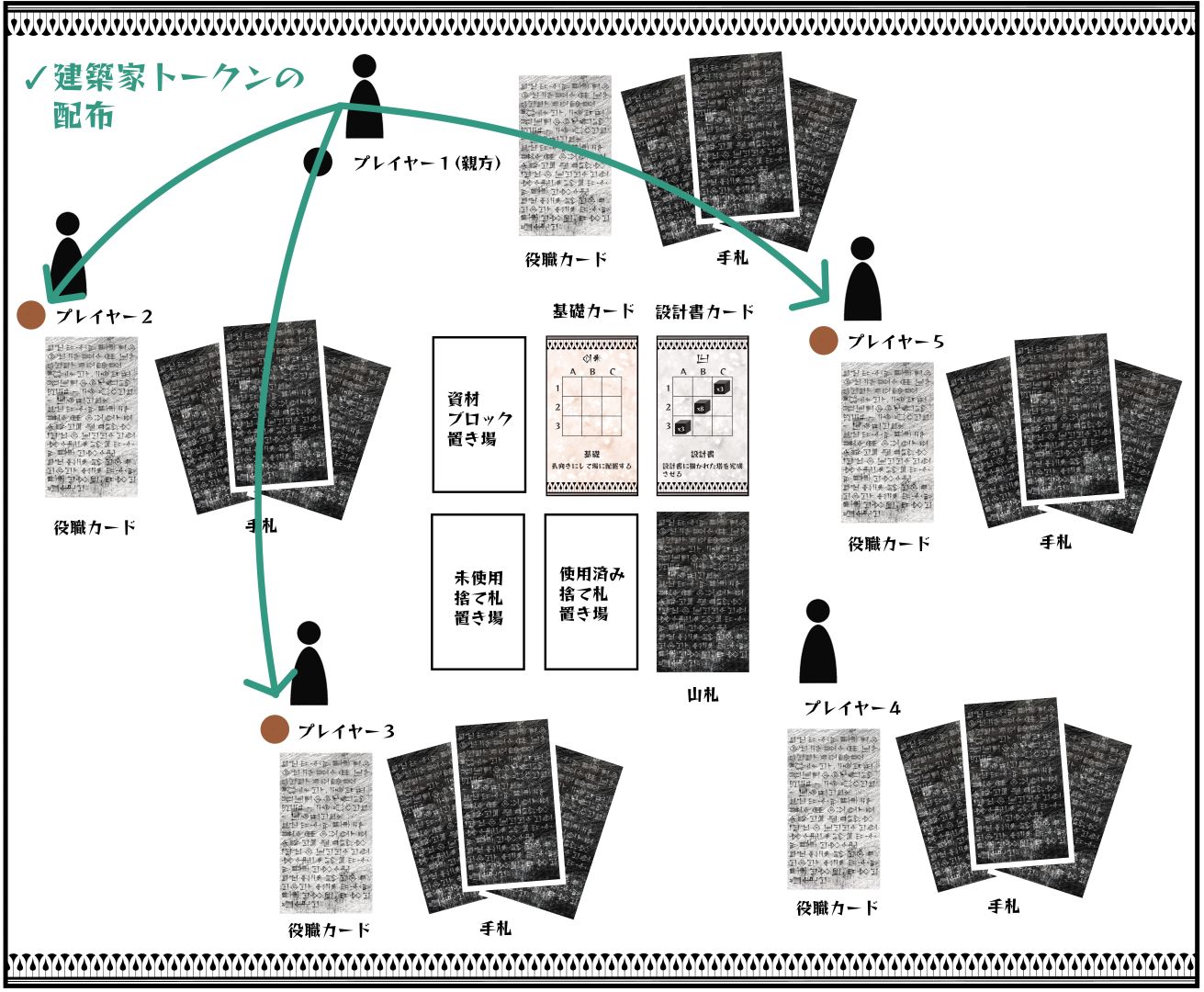
2. Construction Phase
- Card Selection
- Appointed architects select one card to play and one card to discard from their hands.
- The play card is given to the Master face down (the Master must not view the cards at this point).
- The discarded card is placed face down on the table, ensuring each player’s discarded card is distinguishable (do not shuffle).
- Master’s Action
- The Master shuffles and checks the received cards.
- If a Storm Card is included, it is immediately revealed and its effect is applied. This halts the current construction (any instruction card played is rendered useless).
- The Master selects one card from the remaining cards and swaps it with one card from their hand. The swapped card is discarded face down.
- Reveal and Apply Card Effects
- The remaining cards are revealed one by one, and their effects are applied. The Master chooses the order of reveal.
- Card effects are as follows:
- Instruction Card: Stack blocks on the base card according to the instructions.
- Lightning Card: Remove two blocks from the highest tower. If multiple towers are of the same height, the Master chooses one.
- Deliberation Card: The Master selects one architect who participated in the construction phase to reveal their discarded card.
Note: Card Selection
Click (or tap) to enlarge. To close, click the “✕” mark in the top right corner.
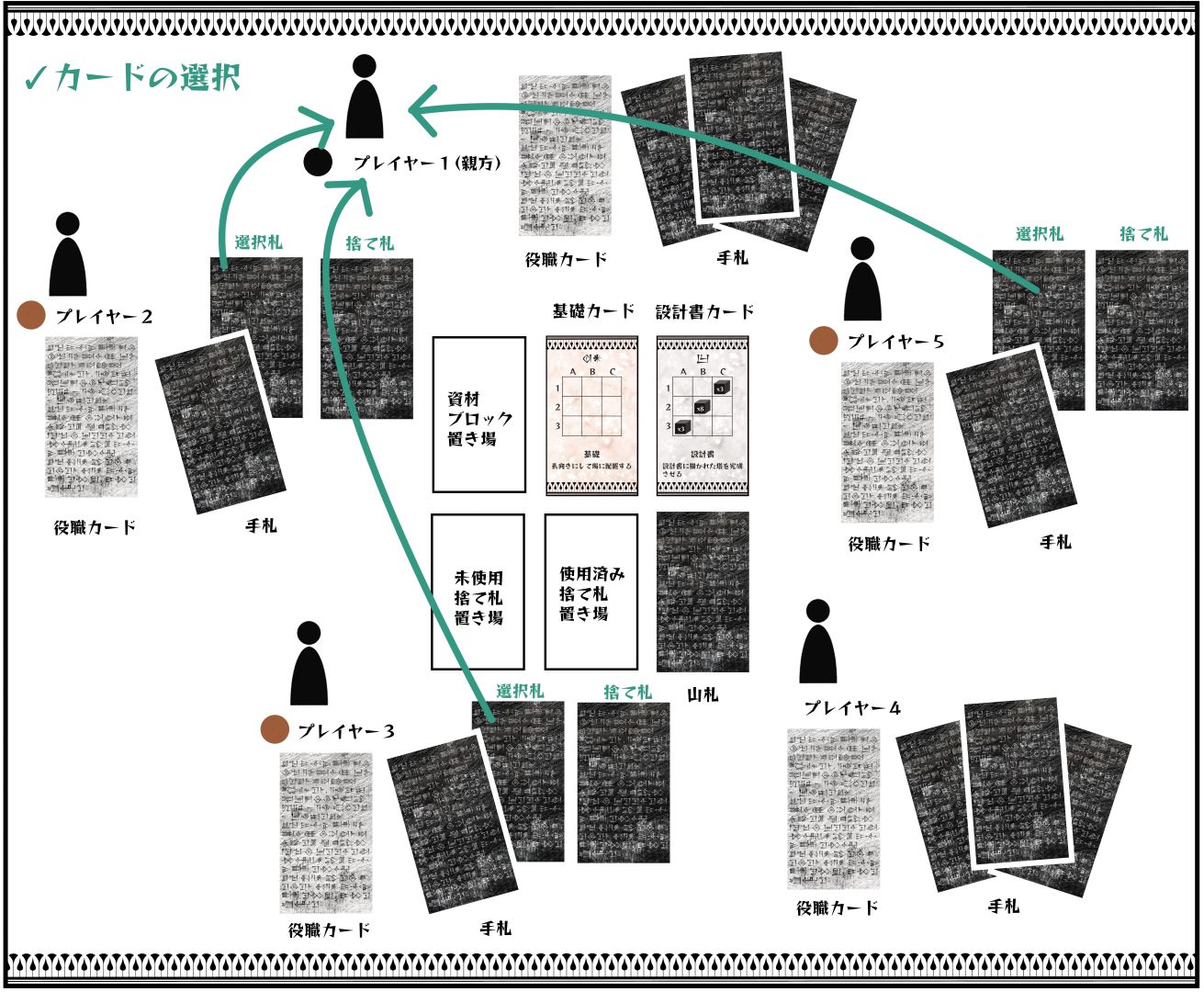
Note: Master’s Action and Application of Card Effects
Click (or tap) to enlarge. To close, click the “✕” mark in the top right corner.
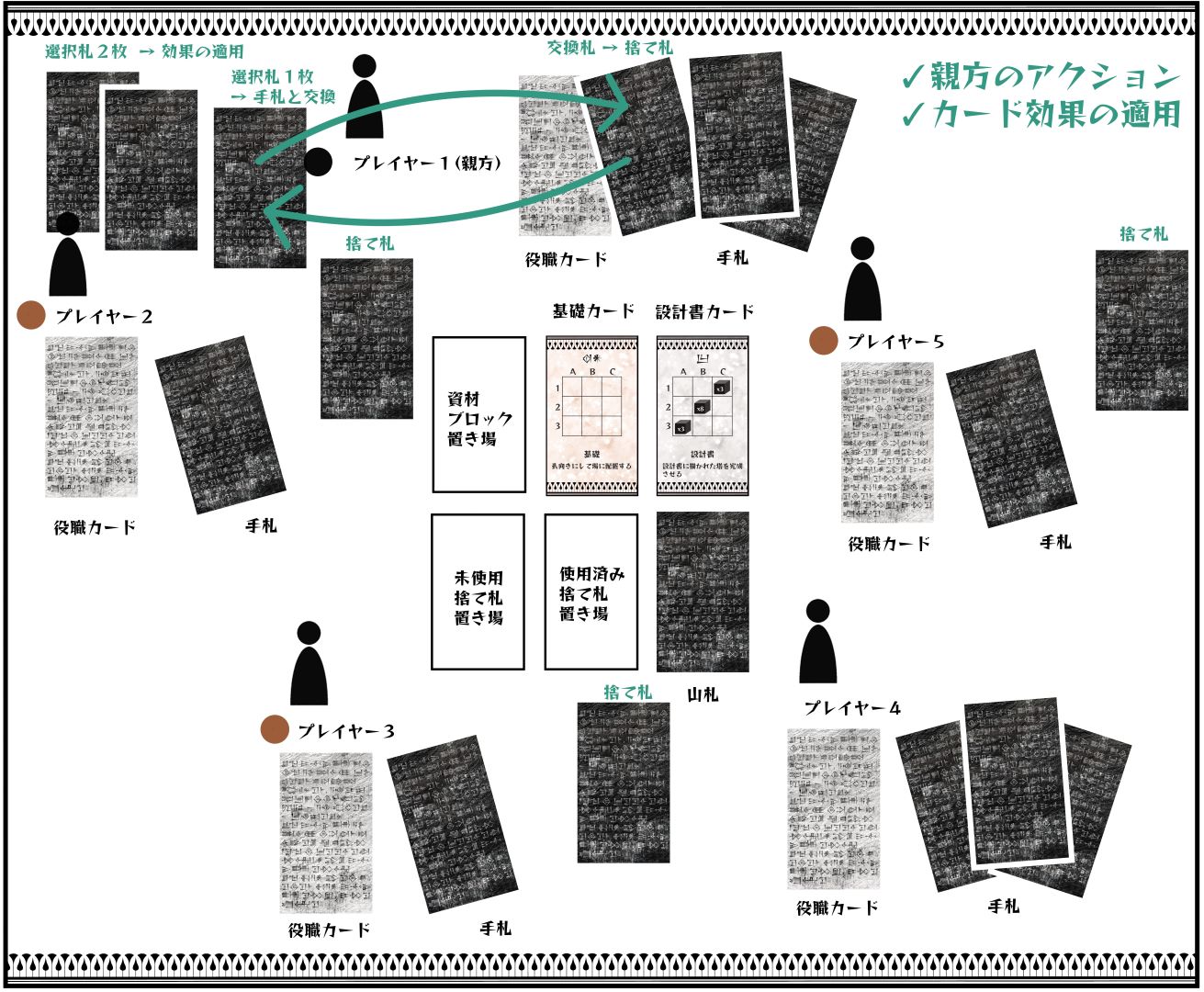
Important Rules in the Construction Phase
- Handling of Divine Punishment Cards:
- Architects may neither “discard” nor “give” Divine Punishment cards to the Master. They must retain them in hand.
- If the Messenger of God has one or more Divine Punishment cards, they must “give them to the Master.”
- If a Zealot has two or more Divine Punishment cards, they must “give them to the Master” but keep one card.
- Master’s Handling of Divine Punishment Cards:
- If a Divine Punishment card is received, the Master must exchange it with one card from their hand. However, the Master’s behavior changes based on their role:
- Architect
The moment the Master (Architect) receives a Divine Punishment card, they immediately become a Zealot. - Messenger of God
Receiving a Divine Punishment card does not change the Messenger of God’s role. The Messenger can use the received Divine Punishment card to pass it to a new Master in the following Construction Phases, increasing their allies (Zealots). - Zealot
Receiving a Divine Punishment card does not change the Zealot’s role. The Zealot can use the received Divine Punishment card to pass it to a new Master in the following Construction Phases, increasing their allies (Zealots). Note that if the Zealot already holds a Divine Punishment card in their hand, that card cannot be exchanged.
- Architect
- If, by chance, the Master has only Divine Punishment cards in their hand (meaning there are no other cards to exchange), all Divine Punishment cards are revealed, and the Messenger of God/Zealot team wins immediately (Divine Punishment Confirmation).
- If the Master receives two or more Divine Punishment cards in a single Construction Phase, all received Divine Punishment cards are revealed, and the Messenger of God/Zealot team wins immediately (Divine Punishment Confirmation).
- If a Divine Punishment card is received, the Master must exchange it with one card from their hand. However, the Master’s behavior changes based on their role:
- Handling of Seal Cards:
- The Master may play Seal cards during the construction phase, though they have no effect (discarded).
Communication Recommendations
- Avoid directly discussing hands or chosen cards.
- Use indirect expressions like “I have a good card” or “I couldn’t play a great card this time.”
3. Victory Condition Check Phase
- Completion of the Tower: If the tower meets the blueprint card conditions, the Architect team wins and proceeds to the Seal Phase.
- The tower is considered complete when it has the required or more blocks as per the blueprint.
- Deck Depletion: If the deck runs out before the tower is complete, the Messenger of God/Zealot team wins.
- Divine Punishment Confirmation: If Divine Punishment is confirmed as per the “Important Rules in the Construction Phase,” the Messenger of God/Zealot team wins.
4. Hand Replenishment Phase
- Architects who participated in the construction phase draw cards until they have three in hand.
- Non-participating players retain their current hand.
5. Master Appointment Phase
- The current Master appoints a new Master (other than themselves) and passes the Master Token.
6. Proceed to the Next Round
- Repeat rounds until victory conditions are met.
6. Seal Phase and Divine Punishment Phase (Reversal) if Architects Win
1. Seal Phase
- Declare Use of Seal Cards
- Architects with Seal cards declare their use.
- The Messenger of God and Zealots may also use Seal cards.
- Discussion
- All players discuss who they believe is the Messenger of God.
- If multiple players intend to use Seal cards, they cannot discuss their intended targets directly but must decide individually.
- Selecting the Target for Sealing
- After discussion, players with Seal cards simultaneously point to the player they wish to seal (duplicates allowed).
- Seal cards are handed to the indicated player.
- Only one Seal card per person can be used.
Proceed to the Divine Punishment Phase.
2. Divine Punishment Phase
- Zealot Reveal
- Zealots reveal themselves.
- No discussion or speaking is allowed in this phase (except for rule clarifications).
- Using Divine Punishment Cards
- Zealots simultaneously point to the player they believe is the Messenger of God (duplicates allowed).
- Divine Punishment cards are handed to the indicated player.
- Messenger of God Reveal
- The Messenger of God reveals themselves.
- Determine Victory
- If the number of Divine Punishment cards the Messenger of God receives is equal to or greater than the number of Seal cards (Divine Punishment Cards ≥ Seal Cards), the Divine Punishment is executed, and the Messenger of God/Zealot team achieves a comeback victory.
- If the number of Divine Punishment cards is less than the number of Seal cards, the Architect team wins (Seal Successful).
7. Other Important Rules
- Role Declaration Prohibited
- The Messenger of God and Zealots cannot declare their roles. Players who declare their roles cannot become the Master.
- If the Master declares themselves as the Messenger of God or a Zealot, they must return the Master Token and a new Master is chosen.
- If you accidentally knock over the tower under construction
- There is no penalty. Stay calm, restack it to its original state, and resume the game.
- Handling of Discard Pile
- Discarded cards are removed from the game. The discard pile is not shuffled back into the deck, even if it runs out.
- Hand Limit
- The hand limit is three cards. Players may not exceed this limit.
- If the Master Becomes a Zealot
- Even if the Master becomes a Zealot after receiving a Divine Punishment card, they continue their role as the Master.
- If No Architect Has a Seal Card
- The Seal Phase is skipped, and the game proceeds to the Divine Punishment Phase.
- Communication Among Players
- Players are free to talk and exchange information outside the construction phase. However, direct references to roles or hands should be avoided.